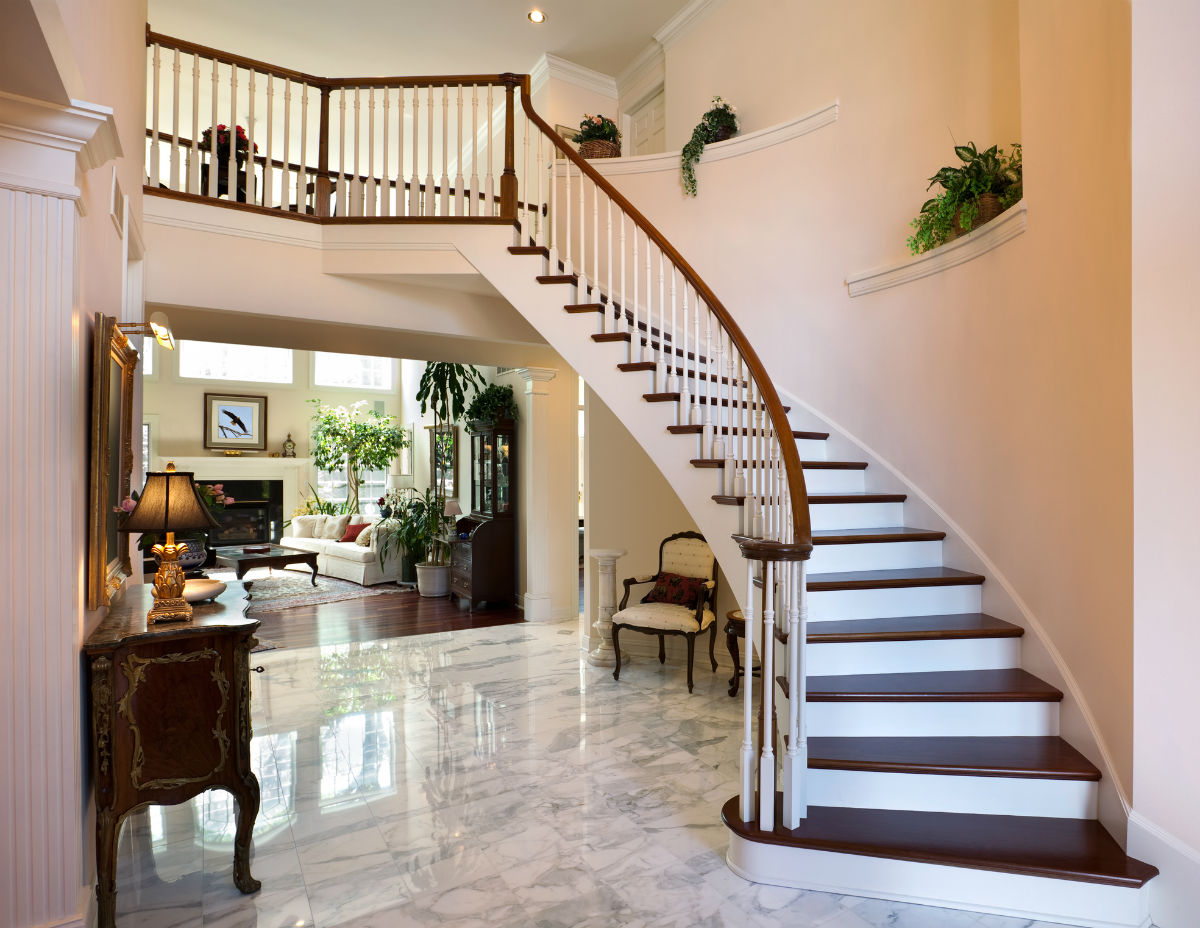

We may earn revenue from the products available on this page and participate in affiliate programs. Learn More ›
Beautiful marble flooring started its journey into our homes as limestone. Millions of years of metamorphosis—intense heat and pressure—produced a dense variegated stone that can be polished to a high shine. Marble is now mined throughout the world and is highly prized as a natural product for countertops and flooring. Polished marble reflects light to make rooms seem more spacious while offering a touch of elegance.
Like many types of stone flooring, marble is often installed in “wet” environments, such as kitchens and bathrooms, where frequent water splashes can be simply wiped away without causing damage. However, marble is susceptible to staining, especially due to highly acidic and alkaline substances, including coffee, juice, wine, soda, vinegar, berries, tomato products, tobacco, oil and grease, baking soda, ammonia, harsh detergents, bleach, and in some parts of the country, “hard” tap water. Marble is also very sensitive to staining from pet urine, which can cause permanent damage and etching of the floor, making marble a less-than-ideal choice for households with furry friends. The best way of keeping your marble looking fabulous is to invest in a good-quality marble sealant, and blot up any spills promptly with a soft, absorbent cloth. Be sure to blot rather than rub the stains: if you rub marble in a circular pattern or scrub it too aggressively, you can damage the surface and make it look dull.
If you’re thinking about incorporating this fabulous flooring into your home design, read on to learn about the different types of marble available, how to choose the best one for your budget, and glean some DIY tips should you opt to tackle marble flooring installation yourself.

1. There are many types of marble flooring, which can be sorted into three main categories.
Marble flooring tiles come in varying colors and surface patterns. The contrasting color lines running through the surface are known as veining, which can be heavy and pronounced or delicate and barely noticeable. While more than a hundred varieties of marble exist, there are three main categories, each type identified by its appearance.
- Carrara: This popular white marble flooring option was used centuries ago in ancient Greece and Rome, appearing in massive pillars and elaborate statues. Today, Carrara marble flooring tiles can be found in limited hues, ranging from light to warm white, and its surface features medium to light gray veining.
- Calacatta: A white marble similar to Carrara, Calacatta is closer to pure white in color and features darker gray veining, which creates a contrasting look.
- Breccia: If you’ve been wooed by black marble floors, you’ll most likely be looking at Breccia. Breccia marble offers more color and warmth than Carrara and Calacatta. You can find it in a range of deeper shades, including warm golds, tans, deep browns, black, and reds. The dark gray and black veining in Breccia marble tends to appear in ornate swirls, and it frequently includes perfectly round outlines that resemble bubbles trapped beneath the surface.
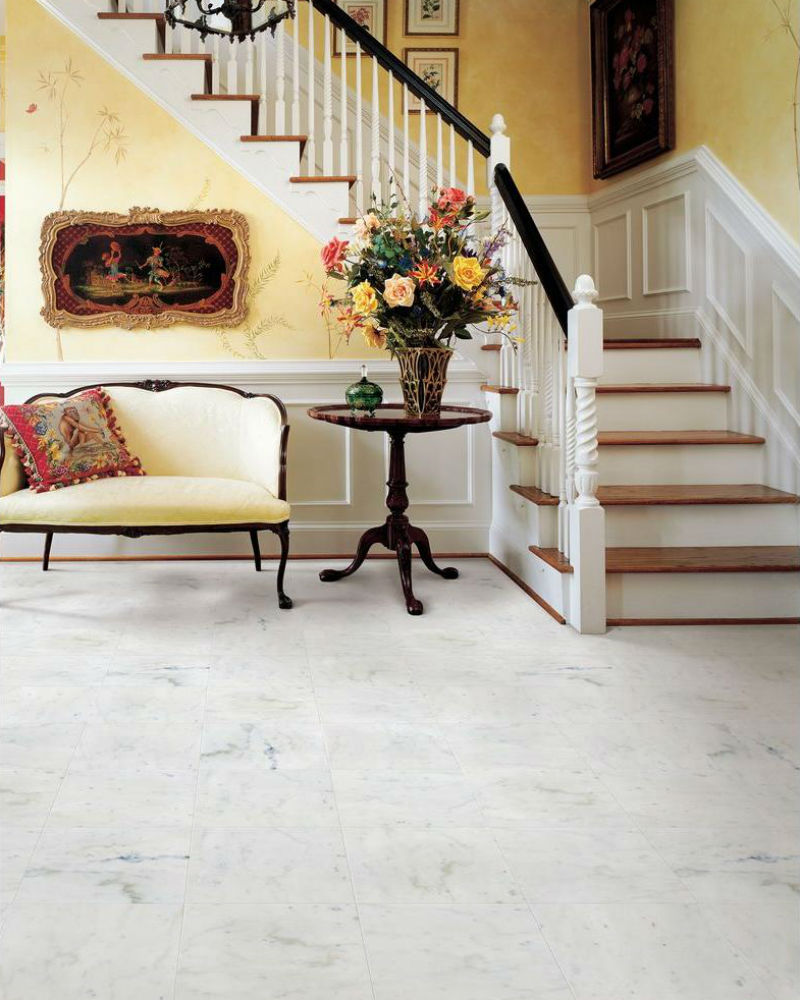
2. Marble flooring isn’t always shiny, nor should it be.
The above types of marble can be finished to either a high gloss or a matte look, depending on what’s best suited for the location.
- Polished marble: The most popular option for marble flooring comes with a high-gloss appearance, achieved by grinding the surface with a stone-polishing machine. Polishing marble brings out the veining in the stone and gives the floor a radiant, luxurious look. With the right maintenance (see below), polished marble will retain a reflective finish for many years.
- Honed marble: This type of finish is only lightly polished, just enough to produce a flat, smooth surface, but not enough to create a shine. Honed marble floor tile offers a durable surface with a soft matte finish some consider more down to earth than flashier polished marble.
3. Marble tiles smaller than 2 feet across are most common in home installations.
Marble flooring comes in tiles of differing sizes, ranging from small, 2-inch by 2-inch squares, to large, 6-foot by 8-foot slabs. For residential purposes, marble tiles are rarely larger than 2-foot by 2-foot, because larger slabs, which are very heavy, require specialized installation. Large slabs are usually found only in commercial and public buildings. Tile thickness ranges from ¼-inch to ¾-inch for residential tiles, while commercial marble slabs can be up to 2 inches thick.
Quality also varies by surface design and density. While no industry standard exists, a few factors can tip you off to the tile’s quality.
- Mesh-backed tiles are mounted on a backing of fiberglass resin. These are typically lower-end marble tiles, which are often less dense and more prone to scratching or breaking. Mesh-backed tiles are suitable for low-traffic rooms, such as bathrooms, but they are less desirable in high-traffic areas where they may show signs of wear more quickly.
- Lower-quality tiles may feature filled areas. When you look at the tile straight on, you might not notice any difference, but if you turn the tile at a 45-degree angle, you might spot irregular dull patches, which indicate holes in the tile’s surface have been filled with a resin compound. Over time, the filled areas may work loose, leaving holes in the surface that require patching.
- Marble tiles with deep fissures are at a greater risk of breaking under the pressure of heavy furniture or appliances. To assess the quality of a marble tile, turn it over and check the backside—if a fissure is noticeable on both the front and the back, the tile may crack if something heavy is placed on it.
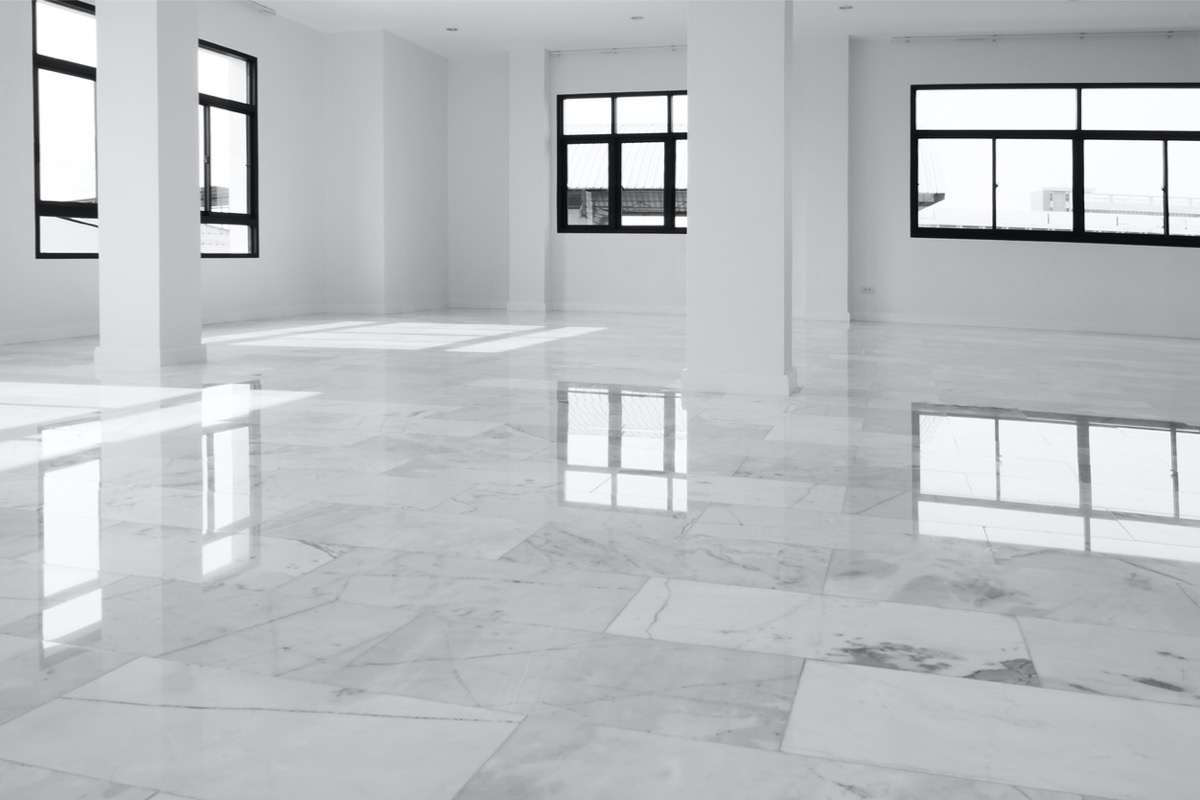
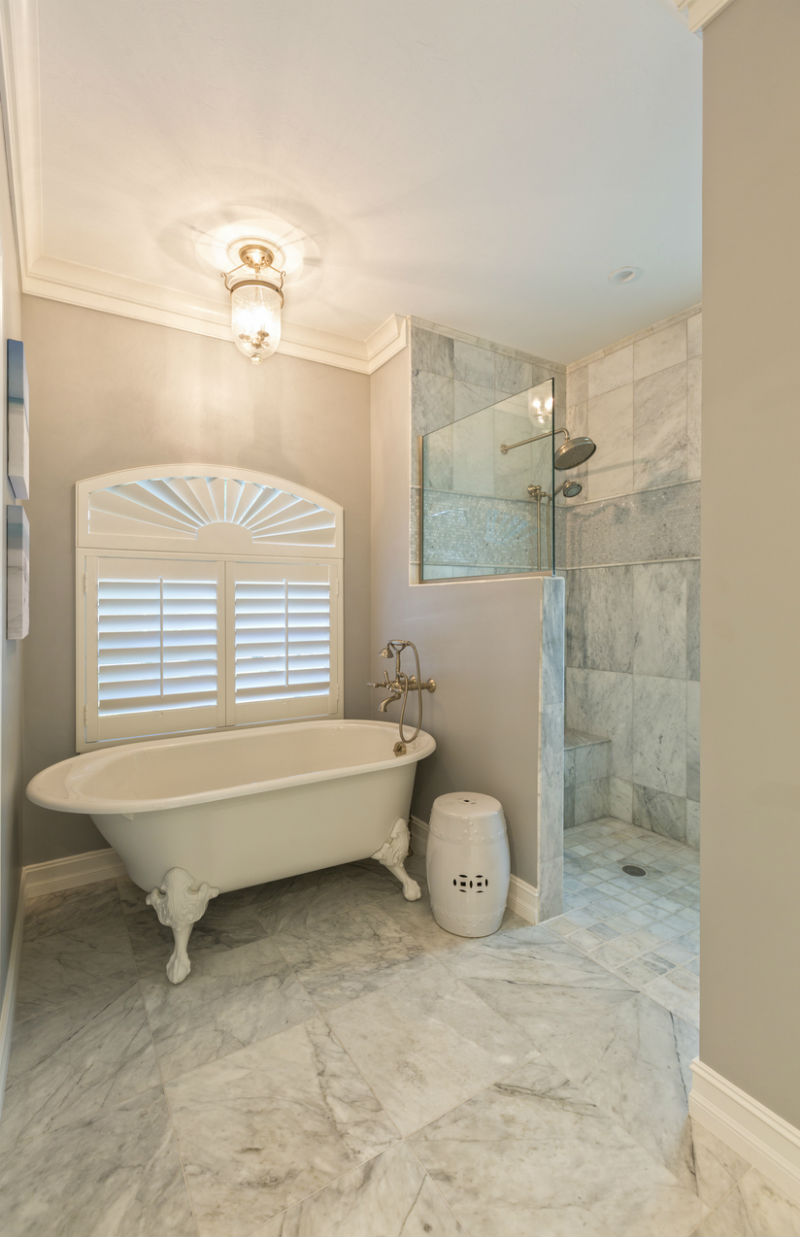
4. The coveted shine on polished marble is slippery when wet.
Unfortunately, the slip factor makes polished marble unsuitable in homes with residents who are at risk of falling. To reduce the slip factor of polished marble, consider using multiple area rugs with non-slip backing, or apply a nonslip product to the floor’s surface, such as SlipDoctors’ Stone Grip Anti-Slip Treatment. Nonslip products are designed to increase the grip traction of the floor without reducing its shine. Honed marble floors are naturally less slippery than polished marble floors.
5. Marble is one of the more expensive flooring options in terms of materials and labor costs.
A good amount of labor goes into quarrying and finishing marble tile flooring, which is why even lower-end marble is pricey. The least expensive marble tiles start around $5 per square foot, and higher-end tiles can run $10 to $40 per square foot, depending on density and veining patterns (fine veining is preferable to heavy veining). Also, the larger the tile, the more expensive it is peer square foot. When comparing the price of marble vs porcelain tile, you can expect to pay as little as $1 to $3 per square foot for the latter.
A budget-friendly option is marble-look flooring: modern printing and finishing technologies mean that you can get a marble look in ceramic tile, or even in vinyl and laminate flooring. Costs range from $1 to $3 per square foot for marble-look ceramic tile, and from $1 to $5 per square foot for vinyl tile or laminate plank flooring.
RELATED: 5 Types of Tile Worth Considering in Your Next Renovation
Professionally installation marble tile can add an additional $3 to $7 per square foot to your budget, depending on the going rate for labor in your area and whether additional work is needed. Factors that could add to your installation costs include:
- Removing and disposing of the existing floor.
- Specialized installation, such as incorporating decorative tile motifs or borders.
- Modifying the existing subfloor. Marble tiles are heavy, and if the existing subfloor isn’t structurally sufficient, it will have to be reinforced before the marble is installed.
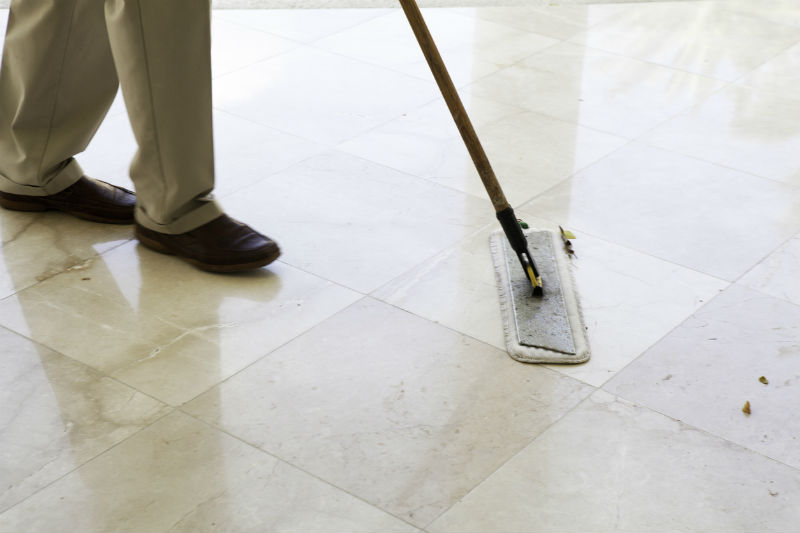
6. Unless you have experience with tile-setting, don’t DIY marble flooring to save money.
As with ceramic and porcelain tiles, homeowners who are knowledgeable in basic tile-laying practices can save a lot of money by installing their own marble floors. However, if you’ve never laid tiles, you’re better off hiring a professional tile setter to do the work. If you opt to DIY the project, keep the following tips in mind:
- The subfloor must be perfectly flat, without dips or bumps that could interfere with the tiles. If the floor isn’t flat, you can apply a self-leveling compound to fill in dips and smooth out the surface.
- Marble tiles should be installed over cement board underlayment, which resists moisture damage. Regular plywood subfloors are not suitable for installing tile.
- Marble tiles can be butted tightly together for an ultra-smooth look, or have gaps between the tiles that you fill with grout. If you go the grout route, be sure to use unsanded grout because sanded grout can scratch the marble during installation.
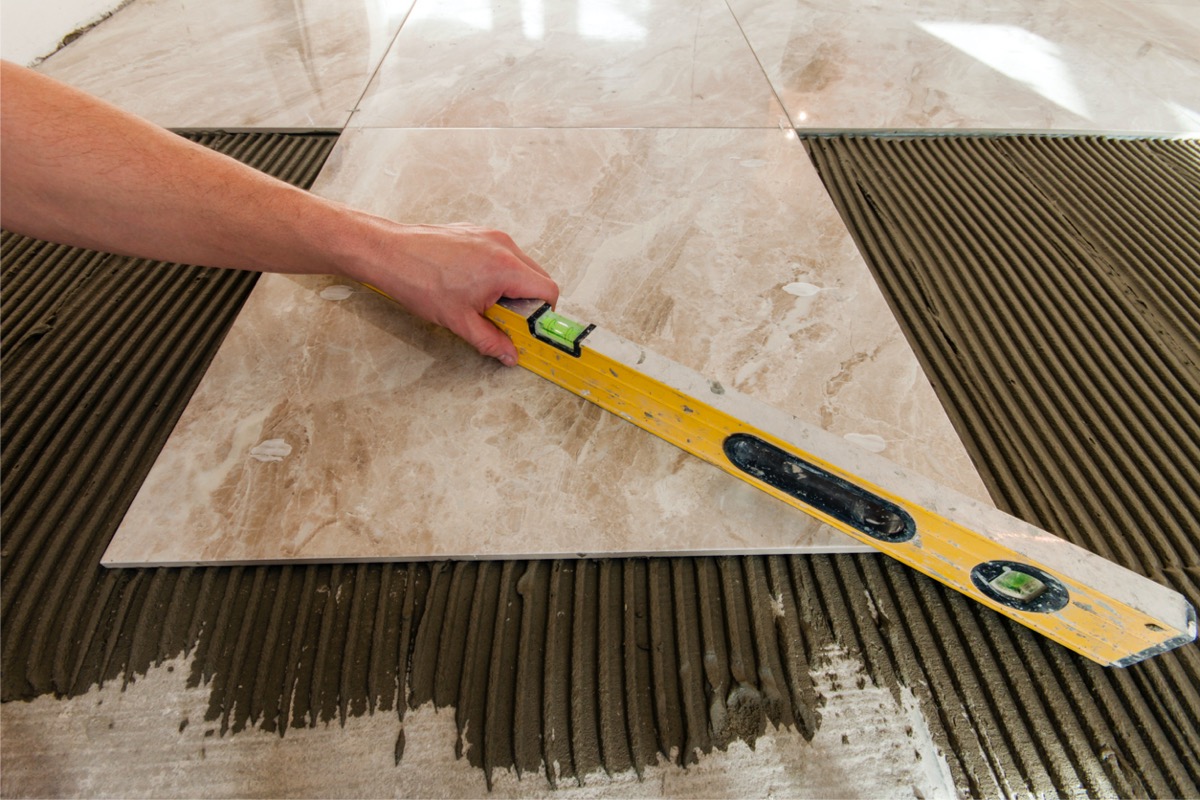
7. Marble flooring requires daily cleaning, prompt attention to spills, and regular sealing.
While marble is a durable flooring, it requires a little extra care to help it retain its beauty.
- Sweep marble floors daily to remove tracked-in sand or grit. Walking over sand particles can lead to scratches on a marble floor.
- Wipe up spills promptly. Acidic liquids, such as orange juice or vinegar, can stain marble. Water won’t stain marble, but over time can dull its surface.
- Seal polished marble floors with a good stone sealant, such as Miracle Sealants’ 1-Step Natural Stone Sealer and Color Enhancer at least once a year. Honed marble is more porous than polished marble, and it’s a good idea to seal a honed marble floor twice per year to help it resist staining.
- Use a mild, non-acidic floor cleaner for regular mopping. The product should specify its suitability for marble floors on the label. Alternatively, make your own gentle floor cleaning solution by combining ½ cup of ammonia and 1 tablespoon of dish soap in a gallon of water.
RELATED: The Best Marble Sealers for a Smooth Finish
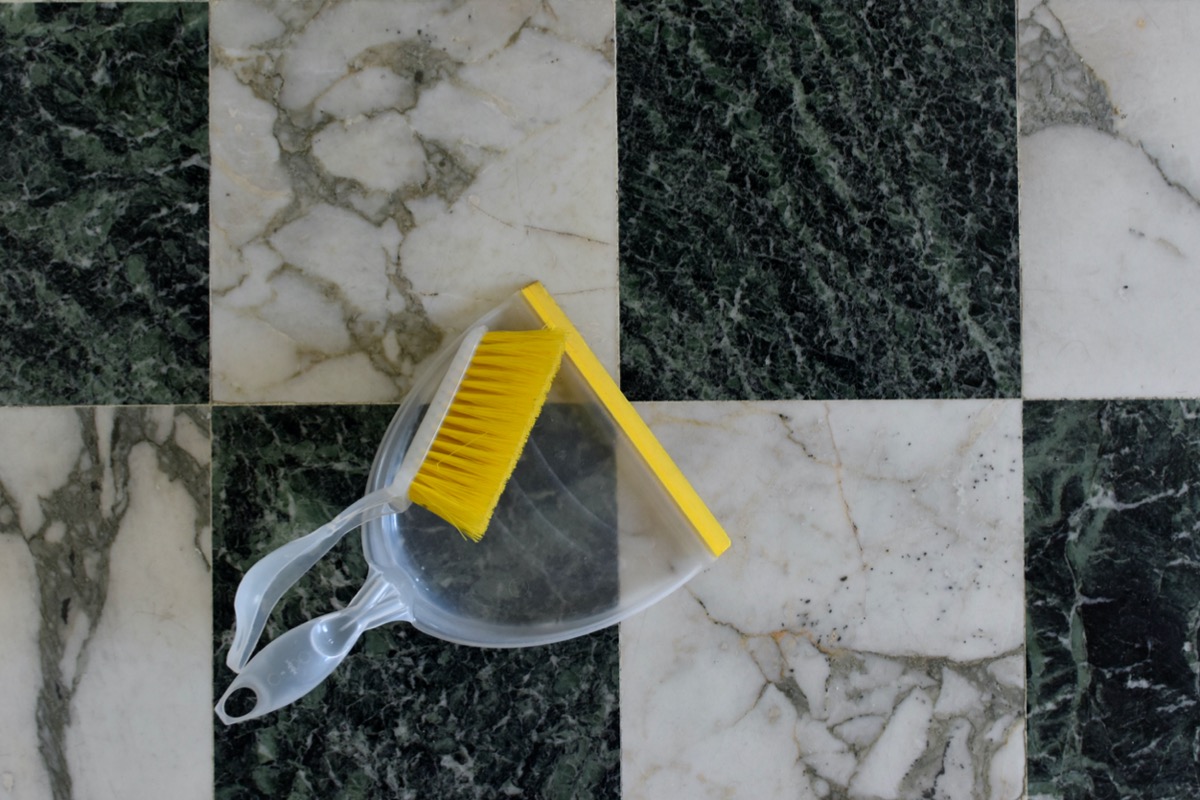
8. Repairing scratches, stains and cracks often requires more than a marble floor repair kit.
If your beautiful marble floors are showing signs of wear and tear, don’t panic: as a natural stone, damage to marble is rarely permanent. Marble floors can be repaired by savvy DIYers, but it is important to use the right technique and the right products. If you are unsure, you may want to call in a professional. The most common issues with marble are overall dullness and surface scratches. There are numerous marble repair kits designed to fix minor scratches and restore a marble floor to its original shine. A good quality marble polish will often do the trick: before applying the polish, wash the surface and buff it with a damp cloth. Apply the polish in thin coats, following the manufacturers’ instructions. Multiple coats of polish may be needed to fill in the scratches and restore the shine; patience is a virtue when it comes to restoring marble.
For extremely worn or scratched floors, it’s best to call a professional to hone and polish the floor. The average cost to polish a 200-square-foot marble floor ranges from $600 to $1,000, with the average being $800.
Deeper scratches and chips may require professional marble repair, depending on the size and depth of the damage. Chips can often lead to cracks, and cracks require professional stone restoration. Crack repair typically involves filling and gluing the crack with a professional-grade adhesive and then refinishing and polishing the surface.
9. Getting cold feet at the thought of installing marble flooring? Consider heated marble floors.
Marble can be cold underfoot, but it has very high thermal conductivity, which means it transfers heat effectively from a heating system to the surface of the floor. Marble also retains a significant amount of heat, which makes it energy efficient.
There are basically two options for keeping your tootsies warm with heated marble floors: toe-kick heaters and under-floor heating, which comes in either hydronic or electric varieties.
Toe-kick heaters have the advantage when it comes to installation: because the units are installed at the level of the floor, often along the base of a vanity or cabinet, but not under the floor, they can be added to an existing marble floor. The units are priced from about $50 and typically plug into a 120-volt circuit. Larger units may require installation by a licensed electrician to ensure adequate electrical supply.
Under-floor heating, also known as in-floor or radiant heating, is installed underneath the marble floor, and therefore has to be put in before the flooring. Under-floor heating is either hydronic, which uses hot water circulating in tubing under the floor; or electric, which uses cables under the floor. The cost of under-floor heating will depend on the square footage of the floor, but a typical “starter kit” begins at $100.
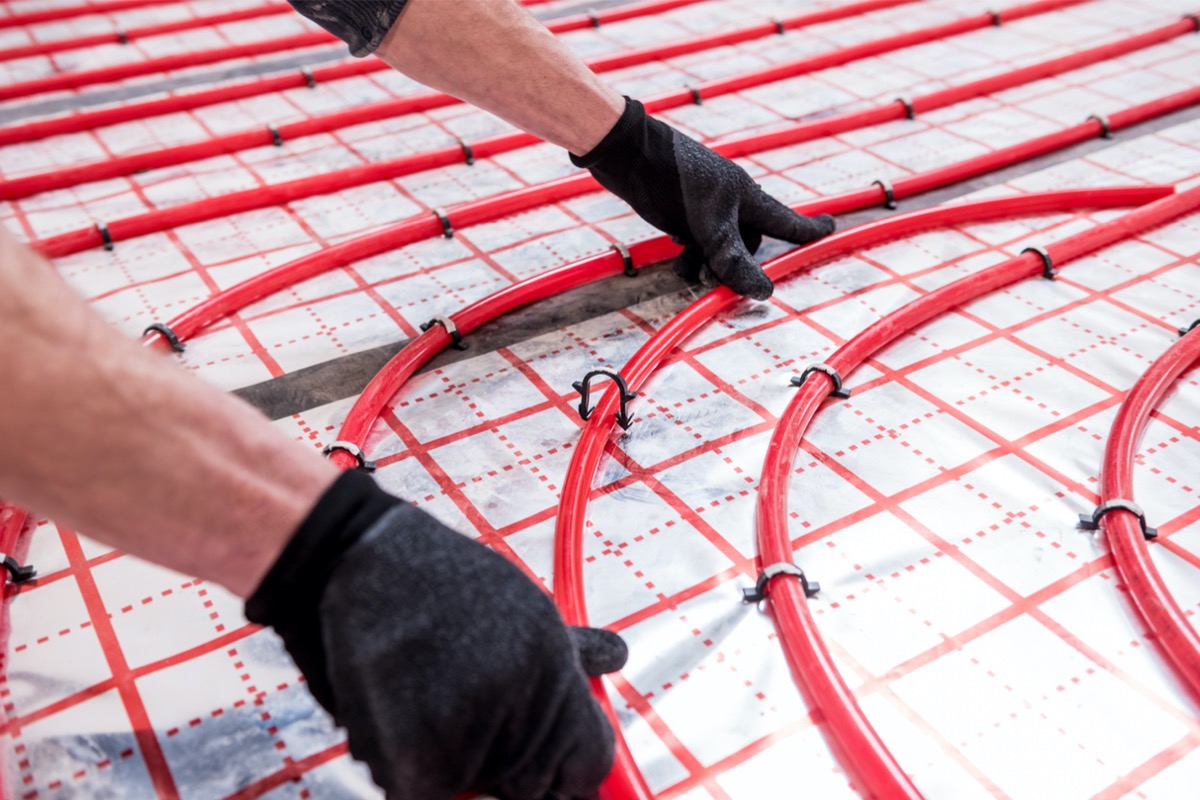
Final Thoughts
Beautiful and luminescent, marble flooring confers an unmistakable air of elegance to the spaces they grace. It has been a popular flooring choice for centuries due to its distinctive veined appearance, and the fact that no two marble floors are alike.
This type of flooring comes in various grades, colors, hardnesses and finishes, making it a versatile and practical choice for many different types of decor. Marble is suitable for use in high-traffic and wet environments, and with proper care and routine polishing and maintenance, it can last a lifetime or more.
FAQs About Marble Tile Flooring
Marble flooring is a flooring option that’s coveted by many homeowners, but as with any home construction material, it’s important to consider the material’s pros and cons. Learn a little more about marble floors by reading these frequently asked questions about them.
Q. How much does marble cost to install professionally, on average?
A. Marble floor tiles can start at about $5 per square foot and go up to about $40 per square foot, depending on the style, color and finish. Professional installation may add an estimated $3 to $7 per square foot to the price, depending on local labor costs and if any additional prep work is needed.
Q. What are the disadvantages of marble flooring?
A. Although marble is beautiful, that beauty comes with a high price tag. Indeed, one of its main disadvantages is that marble is not a budget-friendly choice; it also typically requires professional installation, which adds to the overall cost. Marble is a natural stone and therefore is porous, so it requires regular sealing. Marble can be slippery and cold underfoot, making it a poor choice for people with mobility concerns. Marble also is susceptible to staining, scratching, chipping, and cracking.
Q. How long do marble floors last?
A. Marble floors can literally last a lifetime. On average, a marble floor will last 25 years or more, with proper care, cleaning, and regular maintenance.
Q. Are marble floors pet friendly?
A. Unfortunately, marble floors are not so good for homes with pets. Marble is susceptible to staining by acidic or alkaline substances, and pet urine is extremely acidic. Polished marble floors are also slick and can be scratched by pets’ claws. Therefore, marble floors are not the best choice for pet owners.
Q. How do you maintain marble floors?
A. A regular cleaning and maintenance routine will keep your marble floors looking like new. Use a clean, soft cloth or natural dust mop to remove grit and dirt on a weekly basis. If using a vacuum cleaner, use the softest brush attachment. Minimize dirt and debris accumulation by putting area rugs or runners at entry doors and in high-traffic zones. Wipe up any spills promptly, blotting with a clean, soft cloth (do not rub.) Polish and seal marble floors once or twice a year. And, when the marble starts looking a bit dull, call in a professional to clean, polish, and seal the floors.
